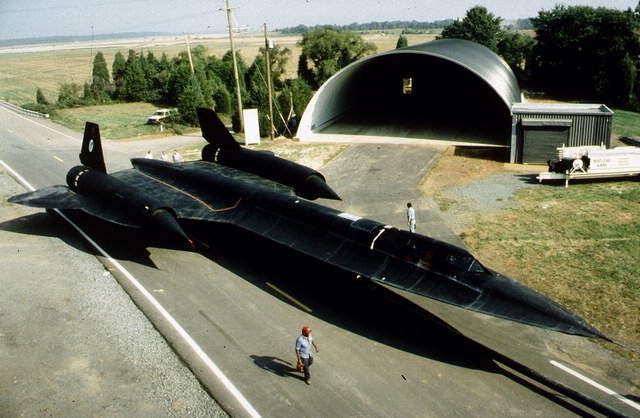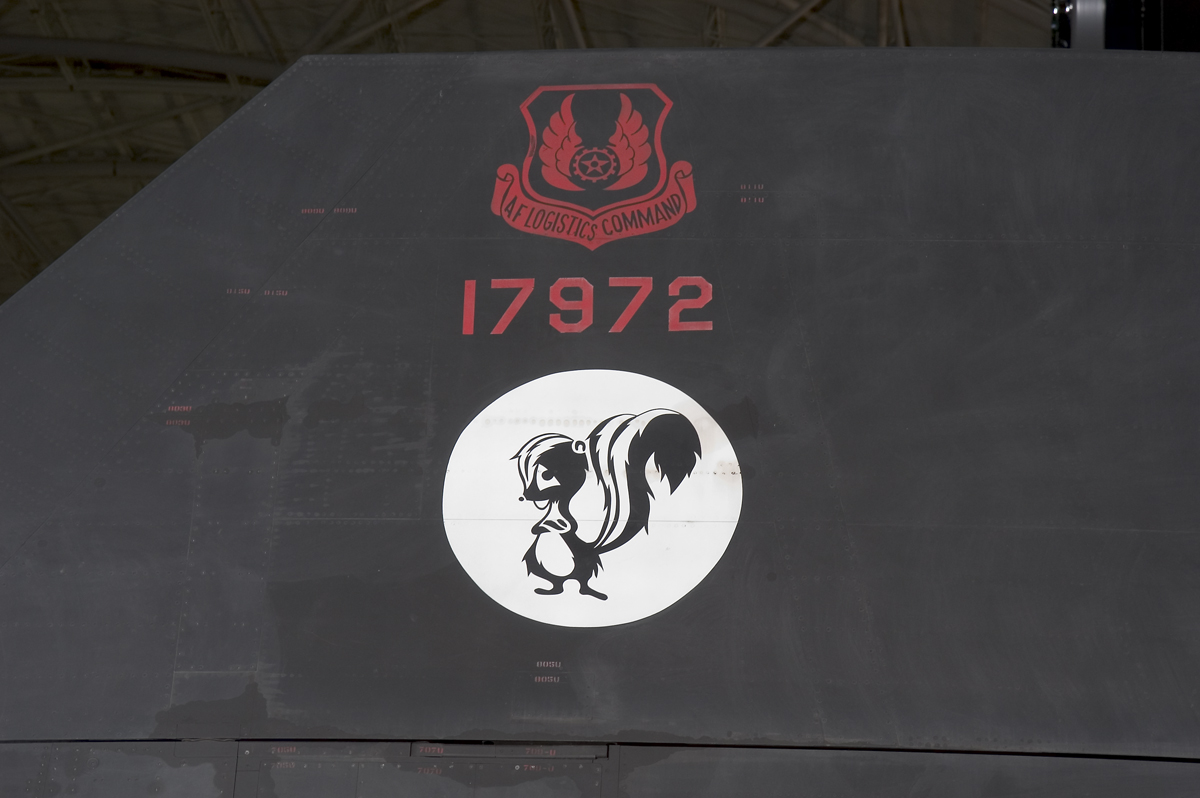
10 Cool Things You May Not Know About The Museum's Lockheed SR-71 Blackbird
Jun 11, 2010
1. Continuous, Supersonic Afterburner. Ever wonder what causes the diamond pattern in the SR-71 jet engine exhaust? It's due to the extra thrust provided by the afterburner which is actually supersonic, creating successive shock waves that show up as the diamond pattern. The SR-71 engines fly continuously in afterburner, except when refueling.
2. It Can Stand the Heat. Flying more than three times the speed of sound generates 316° C (600° F) temperatures on external aircraft surfaces, which are enough to melt conventional aluminum airframes. That's why the SR-71's external skin is made of titanium alloy, to shield the internal aluminum airframe. But the tires, which retracted into the wings during flight, also had to keep from melting! Aluminum was mixed in with latex when the tires were created and they are filled with nitrogen. The tire pressure on the SR-71 was 415 psi (compared to the 32-35 psi in your automobile tires!).
3. Pilots Must Suit Up. SR-71 pilots have more in common with astronauts that you might think. They flew so high (80,000-85,000 ft), pilots had to wear special pressure suits that were actually modified spacesuits.
4. The Secret's in the Inlets: The speed and agility of the SR-71 is largely due to the unique design of the engine inlets. To handle the dramatic changes in air speed and pressure, air literally had to be slowed down to subsonic speeds before entering the jet engines.
5. It's Fast. Really fast. How fast is a typical 747 aircraft moving when it lifts off the runway? 155 knots (185 miles per hour) How fast is the average SR-71 traveling when it lifts off the runway? 210 knots (242 miles per hour) The SR-71 cruised at over Mach 3. It could operate safely at a maximum speed of Mach 3.3 at an altitude more than 16 miles, or 25,908 m (85,000 ft), above the Earth. Other aircraft can approach this speed, but only for short duration. The only other aircraft to fly supersonic for hours at a time was the Concorde, and that couldn't fly Mach 3.3. The Museum's SR-71 holds the world speed record for manned air-breathing jet aircraft.
6. Best of the Fleet. The Museum's SR-71 holds six world records. The most dramatic was its final flight to the Museum when it set a speed record on March 6, 1990. Lt. Col. Ed Yeilding and Lt. Col. Joseph Vida flew from Los Angeles to Washington, D.C. in 1 hour, 4 minutes, and 20 seconds, averaging 3,418 kilometers (2,124 miles) per hour. After landing at Washington-Dulles International Airport, the airplane was turned over to the Smithsonian.
7. Flown by Museum Staff. That's right. The Museum's SR-71 was flown by Tom Alison, a former National Air and Space Museum's Chief of Collections Management. Flying with Detachment 1 at Kadena Air Force Base, Okinawa, Alison logged more than a dozen '972 operational sorties. Museum Docent Buz Carpenter was also an SR-71 pilot and instructor, though he did not fly the Museum's aircraft. Here Buz talks about his longest SR-71 flight on a recently declassified mission.
8. It's A Movie Star. Yes, but no autographs, sorry. Our SR-71 was featured in the major motion picture "Transformers 2: Revenge of the Fallen," as Jetfire. The cast and crew filmed on-site at the Udvar-Hazy Center for 8 days. No, the Decepticon emblem is not actually attached to the nose gear door of the aircraft. We don't think... but it can be seen in the display case located in the nearby Cold War exhibit station.
9. Years of Darkness. In addition to flying secret missions in its previous life, the SR-71 was stored in a custom hangar built solely for its protection in a secured area of the Dulles Airport property after it was turned over to Smithsonian. It remained there for over 10 years until the Museum had a display facility where it could be viewed by the public - the Steven F. Udvar-Hazy Center.

 SR-71 outside former storage hangar at Dulles International Airport. Photo #SI92-14090 by Mark Avino, National Air and Space Museum.
SR-71 outside former storage hangar at Dulles International Airport. Photo #SI92-14090 by Mark Avino, National Air and Space Museum.
10. The story behind the "Skunk:" The first Lockheed aircraft factory was built adjacent to an industrial plastics plant. When the wind blew just right, a horrible odor enveloped the Lockheed factory. The story goes that one day a Lockheed engineer, Irving "Irv" Culver, was so distressed by the odor, he began to answer his phone with the phrase, "Skonk Works, inside man Culver here...," in reference to the then popular comic strip "Li'l Abner" in which a fictitious factory brewed a smelly concoction of ground up skunks and old shoes known to readers as "Skonk Oil". Over time the phrase caught on and the name was eventually changed to "Skunk Works" at the request of the comic strip copyright holder. The little skunk on the tail of the SR-71 is the official logo of the Lockheed secret projects factory.

 Skunk Works logo on Museum's SR-71. Photo #2005-6014 by Dane Penland, National Air and Space Museum.
Skunk Works logo on Museum's SR-71. Photo #2005-6014 by Dane Penland, National Air and Space Museum.
Learn more about the Museum's Lockheed SR-71 Blackbird. Vicki Portway is Chair of Web & New Media and Dik Daso is a curator in the Aeronautics Division of the Smithsonian National Air and Space Museum.
Related Topics

We rely on the generous support of donors, sponsors, members, and other benefactors to share the history and impact of aviation and spaceflight, educate the public, and inspire future generations. With your help, we can continue to preserve and safeguard the world’s most comprehensive collection of artifacts representing the great achievements of flight and space exploration.
Support the Museum
We rely on the generous support of donors, sponsors, members, and other benefactors to share the history and impact of aviation and spaceflight, educate the public, and inspire future generations. With your help, we can continue to preserve and safeguard the world’s most comprehensive collection of artifacts representing the great achievements of flight and space exploration.



